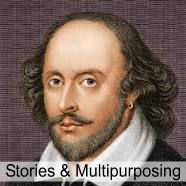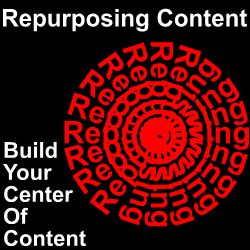Stories and Multipurposing
 Content and Multi-Purposing
Content and Multi-Purposing
A Lesson from Shakespeare
What was Shakespeare trying to achieve? What was he trying to deliver?
Shakespeare desired to deliver a unique and memorable experience. He wanted to deliver a story. He wanted to deliver a well crafted story that could reach into the emotional zone of the audience.
As marketers this is also what we want to accomplish.
Shakespeare realized that it was essential to put the story into a context that the audience could relate to. A story exists in an environment and Shakespeare was expert at establishing the environment with words. His sets were simple. The stories were complex and sophisticated while the themes of the story were universal and intriguing. Themes such as:
- Coincidence (The Comedy or Errors)
- Unchecked Ambition (Macbeth)
- Love and Romance (Romeo and Juliet)
- The Uncertainty of Gender (Twelfth Night)
These themes appeal to many and the words and story telling provide depth of content and intellectual stimulation. Shakespeare’s stories have endured for centuries. His stories and words are memorable.
What can we learn from this?
We need to create our stories for our content marketing. We need to craft them in a format or context that relates strongly to our clients and potential clients. If a case study is the most effective (memorable) way to present information about your product or service then use case studies. If your case studies will be more memorable with high-impact testimonials (specific words) then use high-impact testimonials in your case studies. To use a format that puts your story into a meaningful context and format that your audience can relate to is good marketing. Tell the story in a high-impact manner to help make it memorable and effective.
 Multi-Purposing (or Repurposing)
Multi-Purposing (or Repurposing)
Let’s also consider another view about what Shakespeare created. He created written works that can be read multiple times at the pace of the reader. The format is the tried-and-true book format. However, his works are also in the form of plays and intended to be performed on a stage in front of an audience. He therefore created a performance art and a written art. One item was produced and it takes on two distinct forms. We can do this with our content marketing and we should.
A play is a performance and it is unique even though the specific words are the same. An actor or actress interprets the words and the feelings associated with the words and we gain this interpretation when we attend the play.
Richard Burton’s Hamlet is different than Laurence Olivier’s Hamlet and different from Jude Law’s Hamlet and different again from Michael Brando’s Hamlet. Each performance is unique and different. This is the beauty of a play – the actors and actresses interpret the words and project their interpretation towards and into the audience.
If you have materials that can be made into a video then you can create a mood and feeling that is not possible with a written version of the same material.
You should think about how to create materials that can have the most impact on your audience. A written case study can be viewed multiple times it can be consumed at the pace of the reader. A video can transmit feelings and project a specific interpretation more effectively than written material. Therefore a case study could be both written and a video. A case study could be a podcast or a downloadable PDF document. A case study could be a PowerPoint presentation. You can produce a single case study which can be put into multiple formats.
Advice: Develop your stories and your content marketing plan and once you think of a delightful high-impact story then think about whether it makes sense to create multiple formats for the same story. Shakespeare created works that are presented as plays and in a written format. His efforts are in two different formats and each format makes a contribution that enhances our appreciation of the product.
To further expand upon this consider that you could create a content piece on a case study that would be valuable to your audience. The content piece could take the form of:
1. A written text format website page with images and/or graphics.
2. A Podcast as a verbal and downloadable version of the same case study.
3. A video / slide show with a narration track.
4. A hard copy printed and branded version as a handout at a trade show.
5. A PowerPoint presentation for a speaking engagement.
Think of content marketing as it relates to repurposing your content. Get the most out of your content marketing materials.
